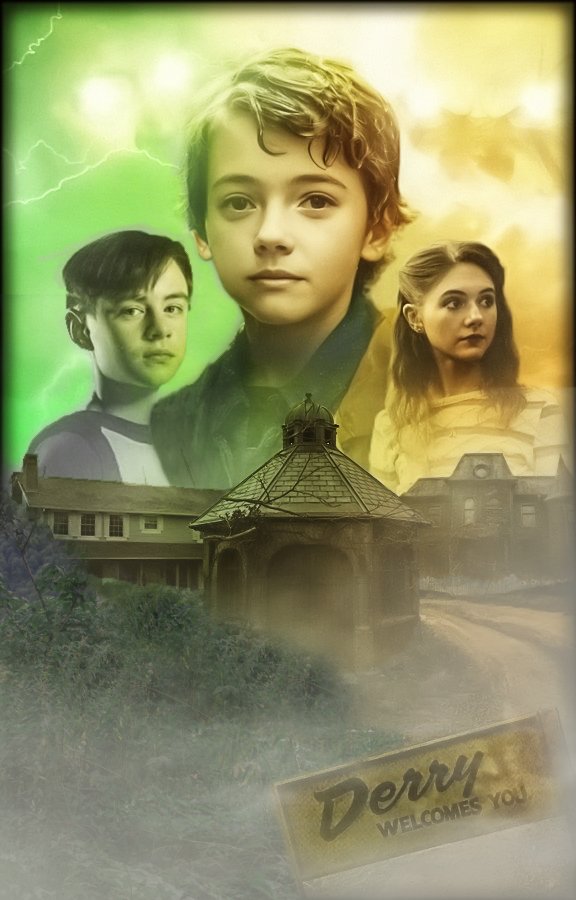-
Posts
667 -
Joined
-
Last visited
Posts posted by AffinityJules
-
-
That looks good. But I still have visual issues with the green casting.
Another suggestion I will venture to make, and this is purely my own preference visually speaking. I would not allow the green and yellow casting at the top of the picture to fall on the children. As it's behind them, it looks a little odd that the front of them are green and yellow. To my eyes it would look better if the children were back-lit by the colours as suggested by the picture layout. A small amount of inner glow, or a blurred layer behind the kids, or use a new child layer to highlight the edges (there's hundreds of ways to do it) would give good results. I attempted it but as I was working on a flattened image rather then a layered composite so it was too problematic.
-
-
It doesn't really matter what I like best or dislike the most, this is your composite and anything that looks good to you, or sits well with your own artistic creativity is all that matters. I only commented because the first thing that drew my attention with your latest update was the fact that everything looked as though it was wrapped in a plastic film. If that's the look you really want then go for it, it's not the thing I would do, but hey, don't mind me.
There is one thing you might want to consider - and this is purely from my own point of view and is of no real importance: I would match up the 3 buildings with light, colour, hue, etc, so that they all look like they belong in the same space that they occupy within the picture.
-
Oh dear.....now everything's wrapped in a plastic film.
-
You're not alone puheOU.
I constantly lose track of where the cursor is - especially when working with grey tones. Zooming in has no effect on the cursor at all.
I have looked at all the available options but have found nothing to change the colour of the cursor, or, to make it more user friendly.
But you never know.....someone in here might have a good solution to the problem.
-
I am at a loss to understand why some people find it so hard to follow a simple, clear instruction.
-
Very nice.
-
Very compelling to watch, I was waiting for something glorious to happen!?
Now I'm a bit depressed.
-
Well....for someone trying to get to grips with Blender, you did pretty good.
Out of curiosity, a few months back, I actually downloaded Blender just to see what it was all about. All I could do was make basic shapes from the presets - and that was it!
After a few moments looking at my screen, I thought "nope," uninstalled it, and never gave it another moments thought.
-
Hey StuartRc!
Just checking out your rather fine asset library, and it always leaves me wondering whether or not the brush sets you create are vector only?
I know 'jack' about vector brushes and their usage, so my real wonder is: do you create raster brushes (is that what they're called?) which can be used in Affinity Photo?
-
2 hours ago, SolidSnake2003 said:
Wow this looks amazing @AffinityJules
Thank you....really having fun with these series of pictures.
-
-
-
-
You must be subtle when simulating rain in a composite; gray smudges will not sell the concept and will look like exactly what they are.
A few comments on previous pages I mentioned whether or not what you're doing looked real enough to sell a concept to a viewer, or indeed yourself? I don't wish to keep repeating myself, but you and I both know what rain looks like out there in the real world, and when we do composites we are trying to approximate the visual aspect of what we know rain looks like.
The picture attached is another quick/rough example of what you should aim for.
You have chosen quite a difficult subject to portray in a composite, rain is never easy - apart from applying a block rain layer, there are all the little details that help to sell the concept. This is where you will have to decide how far you wish to take it in regards to realism. If you're not able to apply the subtle effects needed then you might consider rapping up the image and move on to something else.
Personally, I haven't got the time to keep making these quick examples for your consideration, quick or not it does take up a lot of my time, but with dedicated practice, trial and error, you will slowly learn and get better with your composites. I am no expert, I draw upon what I have learned over the years along with some tricks I picked up. The best teacher of all is nature, study that in all aspects, light and dark, wet or dry, cold or hot, etc.. and then think about how it should look in your composite. And to reiterate, both you and I know if something looks realistic or not when creating a composite.
-
-
6 hours ago, SolidSnake2003 said:
I got the rain splashing images from wikicommons, I started off with the images to try to see if I could create an effect combining both an image and brush effects.
https://commons.wikimedia.org/wiki/File:Rain_splashes_on_rooftop_4.jpg
https://commons.wikimedia.org/wiki/File:Rain_splashes_on_rooftop_3.jpg
In my view those pictures are totally unsuitable for rain in a night scene. Both pictures look like they have been taken during the day and are far too white to sit properly against a dark background without sticking out like a sore thumb. Look for pictures of rain/splashes, etc, against a dark background, it will make it easier to extract. Another thing to consider is the angle of the picture itself, does it match the eye-level view of your composite, or is it higher or lower?
And while I'm at it, do you know how to extract elements from a photograph using channels?
I ask this because I don't know anything about your knowledge base level when using Affinity Photo.
-
11 hours ago, SolidSnake2003 said:
@v_kyr @AffinityJules @carl123 @firstdefence @iconoclast Here is a new preview of the composite I have redone the splashes on the ambulance and added splashes to the umbrella
Hope you all like this new update
In all honesty this could be improved. The rain on the umbrella and ambulance is far too blurry and smudgy, it does not look natural.
Does it look natural to you?
-
When applying special effects to a composite, ask yourself if what you've done sells the concept in your own mind?
If the answer to this question is yes, then there is no problem so carry on with what you are doing.
If the answer is no, then revisit the composite and consider if what you've done would look like it does in reality - real world application, etc.
The picture attached is a rough example of trying to sell/portray a rainy scene concept from a 'dry' photograph.
Does it sell the concept?
You decide.
-
-
11 hours ago, SolidSnake2003 said:
Is it possible to recreate what was created in this tutorial using Affinity Photo?
https://www.youtube.com/watch?v=pMg0BnscrJA
That is difficult to answer with any certainty.
Adobe Photoshop has been around for decades and has always been a global leader in photo editing software. There are functions in photoshop that are not in Affinity Photo at the moment, but as with all software it is constantly under review and development. Some of the tools used in the video are foreign to me in the sense that I do not recognise them for what they are, or what they do?
You can create custom brushes from water samples using Affinity Photo, but the danger therein is you are likely to create repeating patterns when you use it. Nature never repeats itself. So to use custom brushes effectively you will need to create lots of them from different samples to increase your options, and to decrease the risk of pattern creating. Brush creating in Affinity has a lot of options in the editing screen to change a behaviour of a brush when in use, but it will need some practice, trial and error, to produce exactly what you need.
So. Is it possible to recreate what was created in the linked tutorial?
The answer to that is limited by my own knowledge when using Affinity - I tend to stick with what I know and disregard the rest - especially the higher functions.
Yes, it would be possible to recreate some elements in the tutorial, but not all of them simply because Affinity doesn't have the same tools/functions.
In truth it will need someone far more advanced than myself to answer this question in its entirety.
-
Water splashes have been selected from a photograph using the 'load to pixel selection' in the channels option.
The water splashing on the ambulance roof is exaggerated and too big - to show the effect, but in actuality it will need to be smaller.
Using real water samples generally give good results when sized and treated properly.
- firstdefence and SolidSnake2003
-
 1
1
-
 1
1
-
22 minutes ago, SolidSnake2003 said:
How does the splashing look on the ambulance? I'm not sure whats wrong with it.
It's just a repeated pattern...ergo, not natural.
We both know that water splashes never repeat - each maybe similar in looks, but they are never exactly the same.
-
Now that looks more natural.













Wattpad Cover Preview - Made in style of Stranger Things
in Share your work
Posted
I know who Pennywise is but who is the figure on the left meant to be?
All I can make out is green!! 🤔